Supporting Environmental Justice at Superfund Sites
Environmental Justice: Then and Now

PCB contaminated soil in Warren County, North Carolina.
The origins of the environmental justice movement can be traced back to 1982, when North Carolina had announced a plan to dump 40,000 cubic yards of soil contaminated with PCBs to a landfill located in Warren County, one of only a few counties in the state with a majority black population. This decision was the catalyst for a wave of protests, which resulted in the arrest of over 500 environmentalists and civil rights activists.
While the protest was unsuccessful in halting construction, this event brought national attention to the idea that the nation’s environmental problems disproportionately burden its low-income people of color and is widely understood to be the catalyst for the Environmental Justice Movement.
Environmental justice is the fair treatment and meaningful involvement of all people regardless of race, color, national origin or income, with respect to the development, implementation and enforcement of environmental laws, regulations and policies. For overburdened and marginalized communities, environmental justice means equal access to decision making and protections from environmental and health hazards. Learn more about the history of environmental justice here.
Today, Superfund cleanups protect some of the country’s most vulnerable and underserved communities. About 73 million people live within 3 miles of a Superfund site. Compared to the general population, the population within this range is more low-income, has more indigenous and people of color and is more burdened by other environmental stressors (e.g., poor air quality, lead paint, etc.).
EPA’s Superfund program focuses on making a visible and lasting difference in communities, ensuring that people can live and work in healthy, vibrant places. As part of that focus, EPA considers how to address environmental justice concerns throughout the Superfund cleanup process.
On this page:
- Community Spotlights
- Superfund Community Involvement Supporting Environmental Justice
- Environmental Justice Initiatives
- Superfund Tools and Resources for Supporting Environmental Justice
Superfund Community Spotlights
For communities facing environmental justice concerns, EPA's Superfund program can customize community support based on needs, resources and conditions. Below are two community spotlights that highlight EPA support for these communities.

Jacksonville, Florida
In 2010, Jacksonville’s Health Zone 1 was selected as an Environmental Justice Showcase Community. EPA awarded a $100,000 grant to advance the zone’s environmental justice projects and priorities. The project brought a renewed focus on environmental justice issues in downtown Jacksonville and identified many community needs and priorities for guiding environmental investments in the urban core. Supported by SRP and EPA Region 4, the Jacksonville Integrated Planning Process was a community empowerment planning project designed to improve the area’s health outcomes and quality of life. JIPP brought together agency, non-profit and community members to identify priorities and learn together, forming a coalition of community stakeholders to prioritize needs and champion implementation over time. Learn more about the areawide effort here.
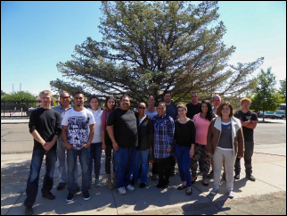
Pueblo, Colorado
In 2018, SRP facilitated a Colorado Smelter Revitalization Project community visioning session, which resulted in a multi-neighborhood revitalization plan. The city formally adopted the plan in fall 2020. The CSRP continues to meet and operate independently. The local health department provides support and resources. Also in 2018, EPA, in concert with NeighborWorks of Southern Colorado, supported a Superfund Job Training Initiative program at the site. Fifteen people graduated from the program, equipped with technical skills and specialized training to work on a broad range of construction projects, including Superfund cleanups. By early 2022, EPA had completed 81 percent of soil cleanups and 49 percent of dust cleanups at residential properties. Sampling, cleanup and reuse planning efforts are ongoing. Learn more about the Colorado Smelter Superfund site here and more about the CSRP here.
Superfund Community Involvement Supporting Environmental Justice

EPA's goal is to provide an environment where all people enjoy the same degree of protection from environmental and health hazards and equal access to the decision-making process to maintain a healthy environment in which to live, learn, and work. The goal of EPA’s Superfund Community Involvement program is to advocate for and strengthen early and meaningful community participation during Superfund cleanups to ensure communities have a voice throughout the decision-making process. Community involvement is a required and integral part of the Superfund cleanup and redevelopment process. At each site, EPA designates a skilled and experienced Community Involvement Coordinator to develop a Community Involvement Plan that is unique to the specific needs of the site and community, including local environmental justice concerns. The CIC provides a point of contact for the community, determines how to tailor outreach to specific community needs, and directs the community involvement activities throughout the process. The community involvement activities selected for each site draw on a robust range of tools and resources developed over the past several decades to specifically to address environmental justice through outreach, translation, needs assessments, technical assistance and capacity building.
Learn more about Superfund Community Involvement.
Superfund and Environmental Justice Initiatives
The Superfund program plays an important role in several environmental justice initiatives.
Justice40 Initiative
Executive Order 14008 created the Justice40 Initiative. This government-wide effort aims to deliver at least 40% of the benefits from certain federal investments to disadvantaged communities. The Superfund program is one of six EPA programs participating in the Justice40 pilot project. As part of the project, the program is:
- Developing a plan to engage with communities and other stakeholders.
- Identifying the benefits of program activities.
- Proposing ways to calculate and report on program benefits for disadvantaged communities.
Learn more about the Justice40 Initiative
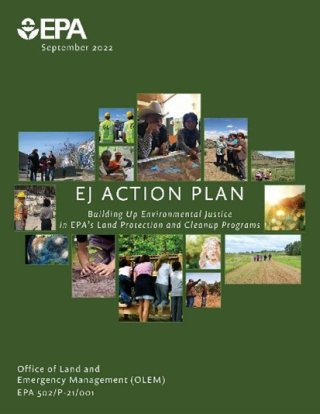
EPA's Office of Land and Emergency Management - Environmental Justice Action Plan
In response to Executive Order 13985 (Advancing Racial Equity and Support for Underserved Communities Through the Federal Government) and Executive Order 14008 (Tackling the Climate Crisis at Home and Abroad), OLEM developed a Draft Environmental Justice Action Plan in 2021 to put in place policies and strategies that strengthen compliance and enforcement, incorporate environmental justice considerations, increase community engagement, and show that at least 40% of the overall benefits from OLEM’s activities occur in disadvantaged communities. The draft plan includes four main goals:
- Strengthening compliance with cornerstone environmental statutes and civil rights laws.
- Incorporating environmental justice considerations during the regulatory development process.
- Improving community engagement in rulemakings, permitting decisions, and policies.
- Implementing the Justice40 Initiative.
Learn more about the OLEM Environmental Justice Action Plan
(Información en español)
The National Environmental Justice Advisory Council
The Superfund program prioritizes community involvement and recognizes the barriers and challenges common to communities with environmental justice concerns. In May 2021, NEJAC released the Superfund Remediation and Redevelopment for Environmental Justice Communities report. Its seven strategies recommend ways for Superfund to achieve faster cleanups in tandem with better outcomes for communities and populations with environmental justice concerns.
Superfund Tools and Resources for Supporting Environmental Justice
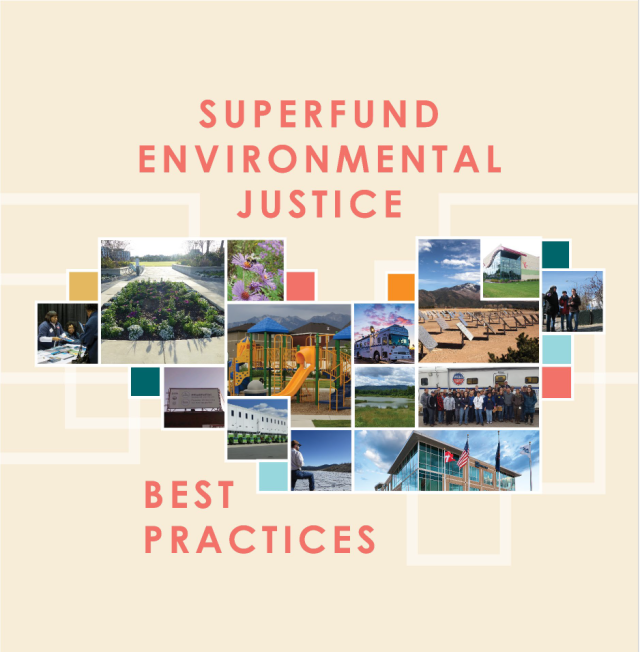
Best Practices: The Superfund Environmental Justice Best Practices document outlines tools, strategies and approaches for site teams to consider while addressing environmental justice concerns throughout the cleanup and redevelopment process.
The memorandum, Incorporating Community Input, Including Environmental Justice Considerations, Throughout CERCLA Investigations and Response Selection, provides recommendations to EPA Superfund site teams about ways to incorporate community input, including environmental justice considerations, when investigating, selecting, and documenting non-time critical removal actions or remedial actions.
Job Training: EPA’s Superfund Job Training Initiative focuses on communities with environmental justice concerns. This environmental remediation job readiness program provides free career development opportunities for residents living in communities affected by Superfund sites. EPA’s goal is to help identify employment opportunities available for these communities during the cleanup process and provide the workforce development skills needed to take advantage of those opportunities. Learn more about SuperJTI.
- Program Contact: Chelsea Sebetich ([email protected])
EJScreen: EPA’s environmental justice mapping and screening tool, provides nationwide data and an approach that combines environmental and demographic indicators, maps and reports. Learn more about how to use EJScreen.
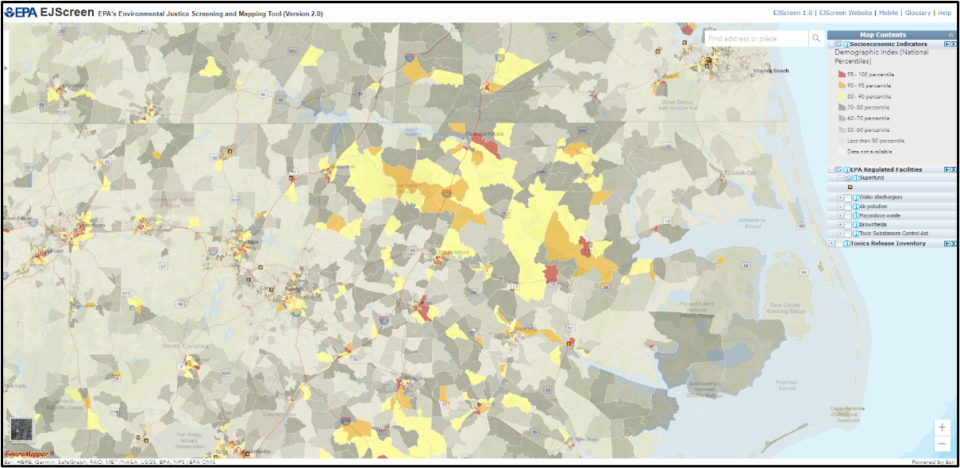
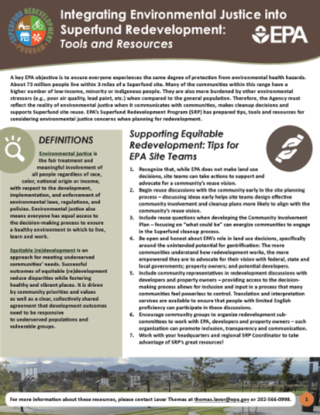
Reuse Planning and Support: EPA’s Superfund Redevelopment Program provides assistance in planning for the reuse of Superfund sites, including bringing stakeholders to the table, clarifying remedy constraints and outlining suitable reuse options. SRP emphasizes effective and inclusive engagement as well as equitable redevelopment and community-wide revitalization in communities affected by Superfund sites. SRP provides a range of reuse planning services and technical support, including situation assessments, reuse assessments and reuse plans. Additionally, SRP developed a fact sheet Integrating Environmental Justice into Superfund Redevelopment: Tools and Resources to support EPA Regions and site stakeholders in facilitating equitable redevelopment of Superfund sites. Learn more about SRP’s reuse planning services.
- Program Contact: Alexis Rourk Reyes ([email protected])
Technical Assistance: EPA’s Technical Assistance Services for Communities program provides technical assistance to support communities in understanding environmental and public health issues and participating in local decision making. Learn more about the TASC program.
- Program Contact: Freya Margand ([email protected])
Technical Assistance Grant Program: EPA’s Technical Assistance Grant Program helps communities participate in Superfund cleanup decision-making. It provides funding to community groups to contract their own technical advisor to interpret and explain technical reports, site conditions, and EPA’s proposed cleanup proposals and decisions. An initial grant up to $50,000 is available to qualified community groups. Learn more about TAG.
- Program Contact: Freya Margand ([email protected])
Technical Assistance Needs Assessment: EPA’s Technical Assistance Needs Assessment is a site-specific process that identifies whether a community requires additional support from EPA to understand technical information and to enable meaningful community involvement in the Superfund decision-making process. Through discussions with community members, EPA identifies how the community is receiving site-related information; what types of information is being received; whether the community needs additional assistance; what types of assistance would benefit the community; and whether there are local organizations interested or involved in site-related issues and capable of acting as an appropriate conduit for technical assistance services. The TANA process produces a blueprint for a coordinated effort to meet a community’s needs for additional technical assistance while minimizing the overlap of services provided by EPA site staff, external partners, and EPA grants and contracts. Learn more about TANAs.
- If your community is interested in a TANA, please contact your Regional TASC Coordinator.
Translation Services: EPA has a language services contract that will provide translation, in-person interpretation, and telephonic interpretation. EPA is committed to providing meaningful access to EPA’s programs, resources, and activities to individuals with limited English proficiency.
- If your community is interested in translation services, please contact the Community Involvement Coordinator for the Superfund site.
